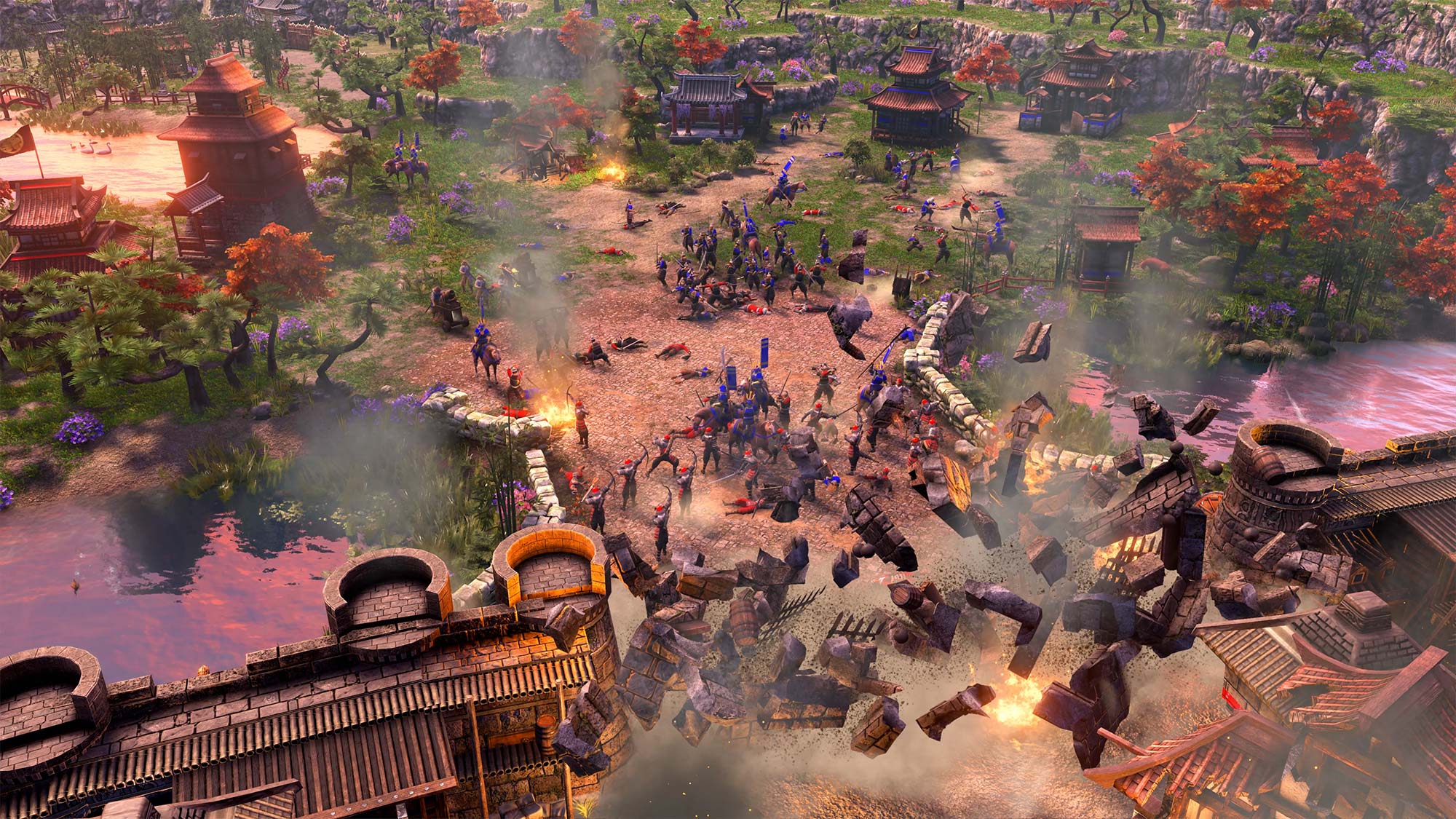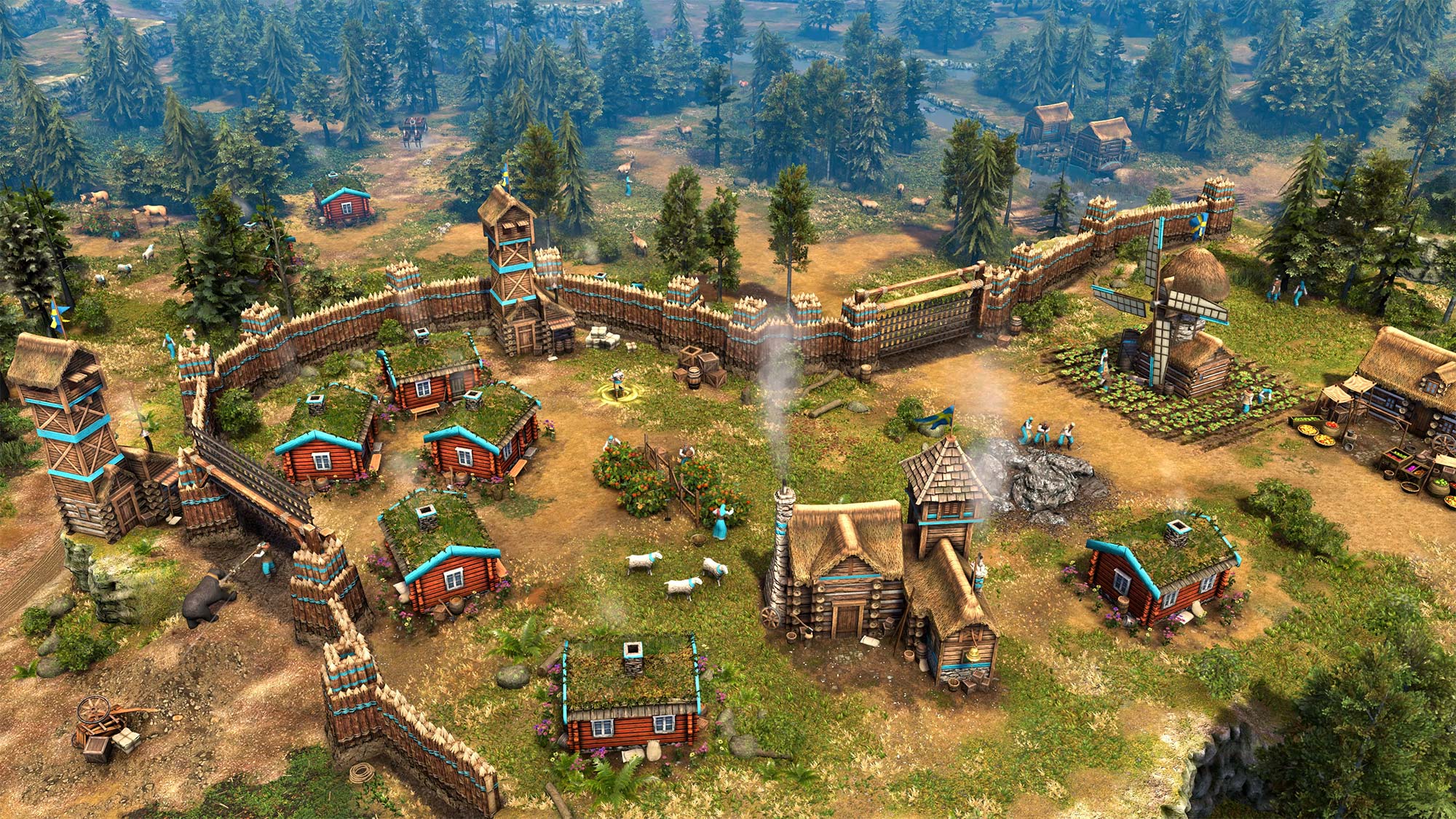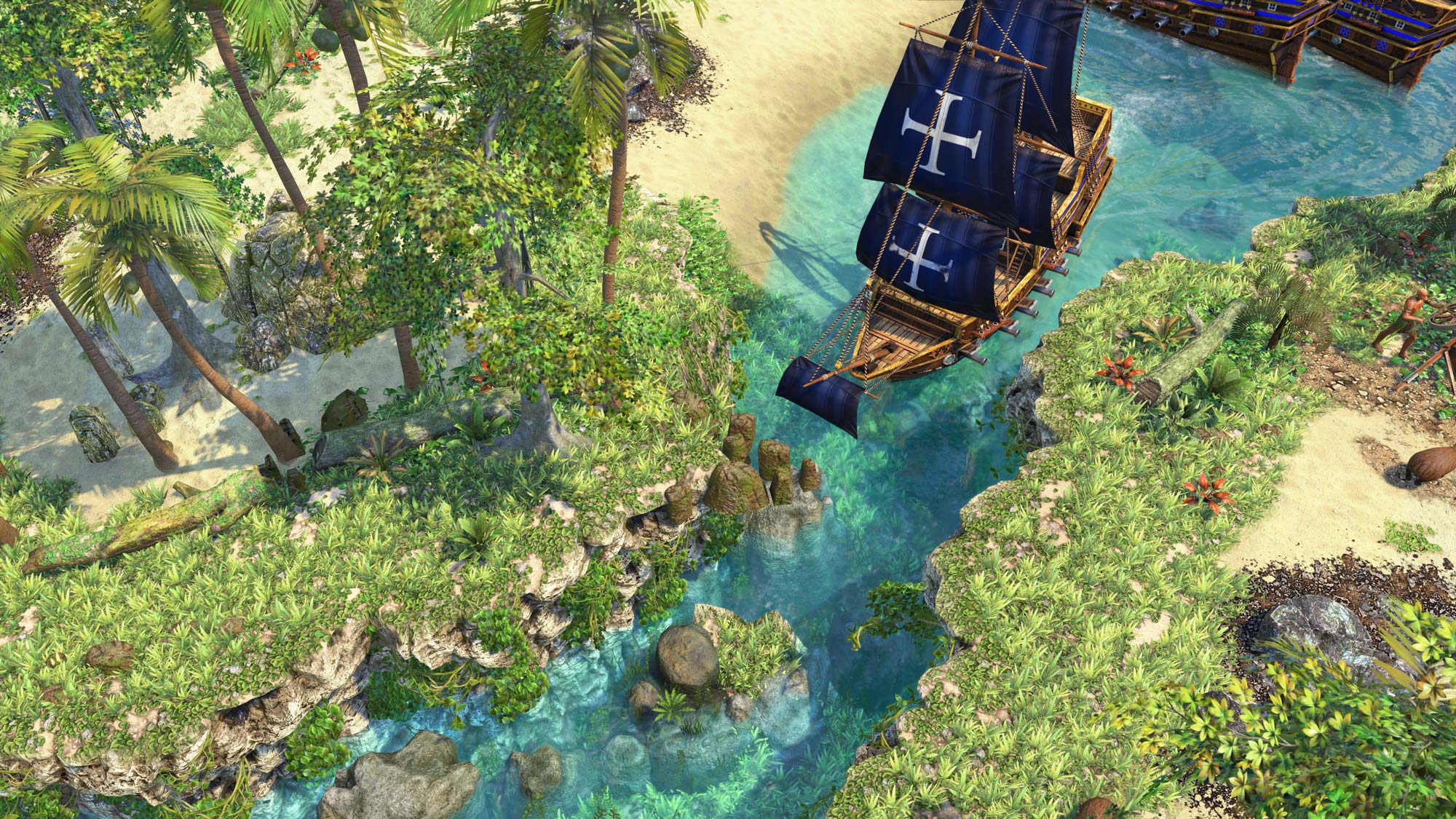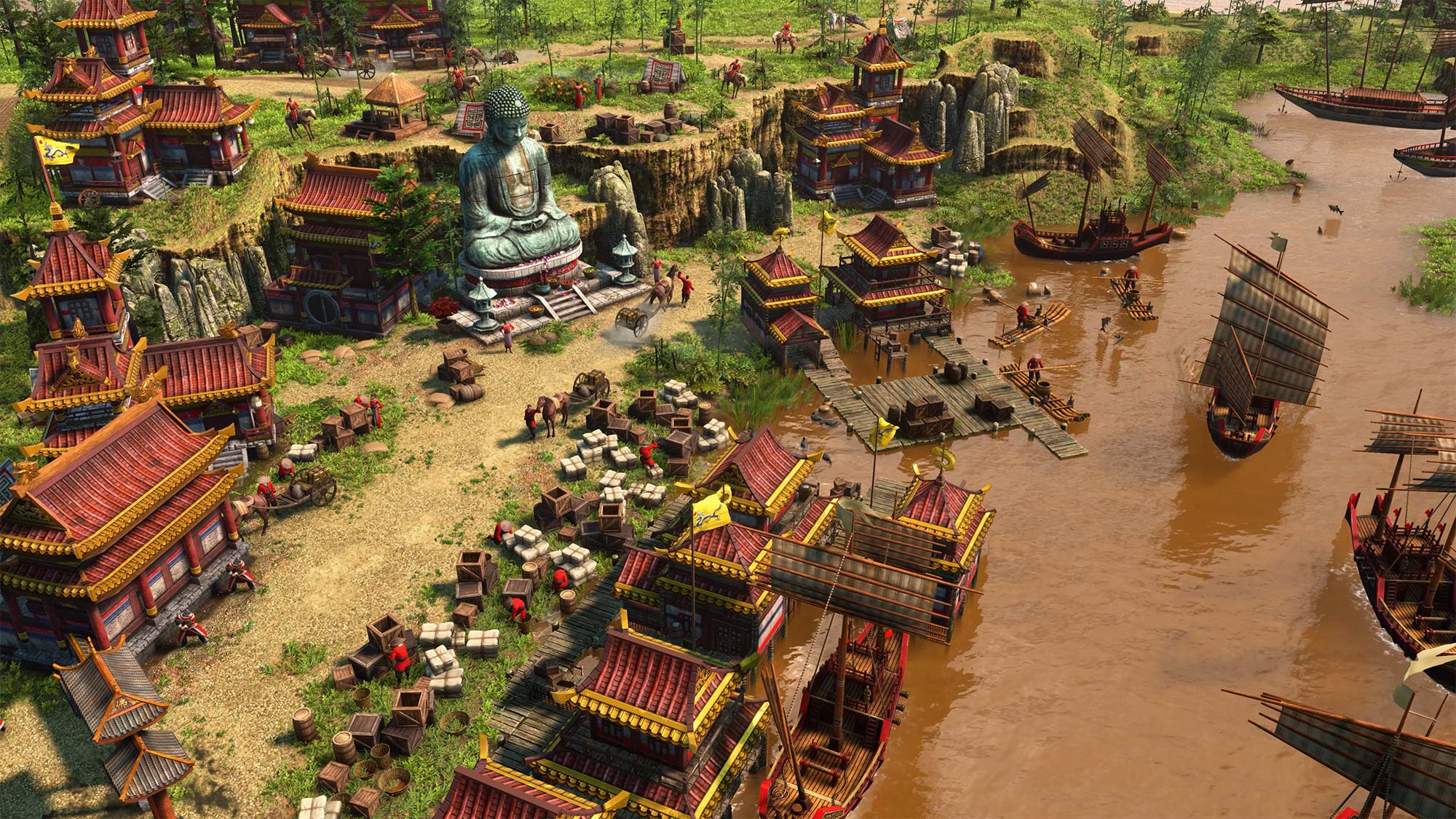
Ahead of Age of Empires III: Definitive Edition‘s (AOE III: DE) October 15th release date, MobileSyrup discussed the latest remake in the iconic real-time strategy (RTS) series with two of the key minds behind the franchise’s revival, Adam Isgreen, the creative director at World’s Edge/Xbox Game Studios, and Bert Beeckman, the co-founder of Forgotten Empires.
Similar to Age of Empires: Definitive Edition (AOE: DE) and Age of Empires II: Definitive Edition (AOE II: DE), AOE III: DE adds a fresh coat of 4K paint to the classic game, though this time to what is arguably one of the less fondly remembered entries in the long-running AOE series.

Given that AOE III:DE was rather forward-thinking for the time thanks to its 3D visuals and a surprising amount of physics for an RTS game, the process of modernizing the title was far more in-depth than it was with previous Definitive Editions.
Forgotten Empires and World’s Edge also put significant effort into ensuring that this new version of AOE III is more historically accurate than its predecessor, added new, much-need tutorial game modes and revamped the game’s ahead-of-its-time card system to be more streamlined.
All of this combines to offer a surprisingly modern-feeling real-time strategy title perfect for holding players over until the long-awaited release Age of Empires IV at some point in the next few months.
Question: With this being the third and final Definitive Edition Age of Empires remake, was there anything you took from those earlier titles and then specifically applied to this one?
Adam Isgreen: I think one of the big ones for me was the ‘Art of War’ [mode]. The idea that we would create kind of an RTS camp for people so they can learn why RTS games are fun. I always love educating players and making them understand why games are fun.
It was so successful with AOE II: Definitive Edition, and so many people loved it, not just because it helped you learn RTS but also because it helped you learn AOE II: DE, which has like 20 years of meta of people how to play the game and good strategies. When we approached AOE III: DE after the popularity of the Art of War mode, we were like, ‘well, we have to put this in AOE III as well.’ And honestly, it’s actually in every AOE game now, so you can expect to see it in AOE: IV as well.
The cool thing about it is it’s not just about teaching the player because it’s also teaching the specific nuances of that game. It’s not just a tutorial mode — it’s a mode that teaches you strategies that are specific to each unique game, and I love that about it, including the fact that it dives in more to the Civilizations and into the play. That’s something that was directly taken from the success of Art of War in the previous game.
Bert Beeckman: It’s always been kind of a journey with the community. It was for AOE: DE, but we ramped it up with AOE II:DE where we were like, ‘okay, let’s involve the community early on and ask them what they want from the game.’ We did this during betas and flights and kept them involved with how they would like to see the game grow from the game that they know to the Definitive Edition. That is something that we definitely learned and then kept on doing throughout the development of AOE III: DE as well.
Q: I definitely found the Art of War super useful in Age of Empires II: Definitive Edition. I played that game a ton growing up and I even briefly checked out the HD remake a few years ago, but it was a great refresher. I’ve never played Age of Empires III, though, and I honestly don’t know why given how much my family growing up played real-time strategy games.
Just anecdotally, a lot of my friends that are into RTS games also haven’t played AOE: III. From your perspective, why do you think AOE: III isn’t quite as iconic or highly-regarded as AOE and AOE: II?
Isgreen: My perspective on it is it definitely came out when RTS games were still really popular. Ensemble was very much enamoured with Blizzard, and they wanted to create a game that was kind of on par with where the developer was going with Starcraft and Warcraft. One of the things that might have been the reason for it is the game is so different than AOE and AOE II. When you have a numerical progression of games, people kind of expect, ‘alright, this is going to be like that thing that I played last time, the demographics,’ there may be some new nuances, but it’s not going to be a completely different game you’re playing, and AOE III is that.
I remember when I was working on other RTS games in the past, and AOE III came out, and I was like, ‘whoa, what is this? This is completely different than what I thought it was going to be.’ It’s a cool game, but it is really different: there’s a card system, there’s a home city system, there’s physics involved now. It was amazing, the difference. I think one of the reasons is that there could have been a little bit of shock, honestly, from players that didn’t expect AOE to make such a dramatic jump away from what they did in the previous age game. At least that’s my take on that, though this is all theory crafting. Bert, what do you think?

Beeckman: I completely followed that reasoning. It was a very different game from its predecessor. So that obviously shapes opinions. Also when I played it back in the day, and then now revisiting it again, I kind of feel that Ensemble Studios was in a way, ahead of its time with a lot of the mechanics. They introduced these mechanics that were like, ‘Oh, that’s new, and maybe too new.’ Then nowadays looking back at it, it’s like, ‘yeah, that’s now common.’ Every game is 3D now and physics are part of a lot of games. Then there’s the card system by itself and the whole explosion in strategy card games. To have that all in one RTS game I found super interesting. I think they were ahead of their time in that sense.
Isgreen: That’s fair. I think that’s really fair. You know, we have a saying in game design that sometimes you want to go from ‘A’ to ‘C’ instead of ‘A’ to ‘B,’ and I think Ensemble did that with Age of Empires III. They went right to ‘C’ and they forgot that people needed a hop to ‘B’ to get to ‘C.’ So some of the things that they decided not to do might have been the thing that made people think, ‘well, I can’t adjust.’ I mean, AOE III is a very popular game, don’t get us wrong, but it definitely didn’t enjoy as much popularity as AOE II did. I think it was probably because expectations were very different from what people got.
Q: Did the emphasis on physics (which are still really cool, by the way) or some of the other unique things the game, like the 3D visuals, for example, make it more difficult to add a fresh coat of 4K paint to the game?
Isgreen: There were some things that were definitely issues. I think it was on what might have been even the first version of Havoc, and now it’s using the most modern version of Havoc in the Definitive Edition. But yeah, 3D added a lot of interesting issues. I think because it was such a new thing. Ensemble had done Age of Mythology previously with that engine, but then when they were working on AOE III, there were still issues with doing an RTS [in 3D] that we’ve tried to eliminate because of the process of having more experience with 3D games now, and understanding what we need to do to better represent terrain and readability.
We’ve made a lot of improvements there that were things that they just probably didn’t even think about at that time. We collectively solve problems in the games industry through all the games that come out. I think that Ensemble just didn’t have the benefit of having that learning when they created the original game. So yeah, there were definitely a lot of challenges of like, “oh, we can update this. Oh, we can fix that. Oh, we can modernize here.” Keeping the feel of the game is always important, but I think that that was one thing we definitely had a lot of challenges doing, but it was nice because there was a lot of learning already there.
Q: When I played AOE II: DE for the first time I noticed a lot of very subtle quality-of-life changes to the game that I really really appreciated as someone who played the game when they were growing up. Was there anything specific that you added to AOE III that longtime fans of the game will see as a change and that maybe someone like myself who’s never delved into the game before might not even notice?
Beeckman: I think — and this is really something both for new players and for old returning players — [that] there is this card system, the home city system, and in the original game, you had to create the home city for every civilization and for every game mode you want to play as that civilization. Then you had to unlock all the cards. I played it a lot as a kid and never got to at least half of the content.

Now, that’s all unlocked. You have all the home cities, you don’t need to create anything anymore. You can still customize them if you want, but you don’t have to unlock them anymore. You don’t have to grind — everything is just there. So you can delve in and try to make combinations. I think that’s the biggest change for new players and old players.
Q: Leading up to AOE III: DE‘s release, there’s been a lot of discussion surrounding changes that were made to some of the Indigenous civilizations in the game. I was hoping you could just talk a little bit about that and explain why you felt this was important to correct in this new Definitive Edition?
Isgreen: One of the things that happened is when we split off from the publishing group, and we became our own studio, World’s Edge, we kind of grew as a studio to work with all these great developers like Bert’s company, Forgotten Empires. We kind of came up with a set of guidelines because we realized that being our own organization, we had a responsibility, given we’re doing these games about history, to really accurately represent cultures. It was something that we took very seriously.
When we do things internally, we create pillars and kind of motivational principles about how we learn to work as a studio. One of them was about how we treat history and the respect that we would show cultures that were in our games. We had done that work but when we started AOE III: DE, we finally kind of embraced those pillars. And we were like, ‘you know, we’re not doing justice to these cultures,’ like it was obvious to us, especially because a lot of the group originally worked on Killer Instinct. I don’t know if you know anything about Killer Instinct, but we had Native American fighters in that game as well.
“There was a point where we were like, do we not ship this because of these issues?”
We went through a ton of stuff to fix the issues and worked with the tribe that was represented in the game through the characters, in order to make them more authentic. We can’t shy away from the issues that the AOE III: DE has in terms of how they’re depicting some of these civilizations, and it was a lot of work. At first, we’re like, ‘Okay, there’s probably going to be some work,’ and then we dove into it was like, ‘oh, my God, this is a big deal. There’s a lot of things that are wrong here.’ We’d already been engaging with cultural representatives from the different tribes, but we got to the point where we’re like, ‘what do we do with this game?’ There was a point where we were like, do we not ship this because of these issues?
The great thing is that all of us have World’s Edge and all of the teams that we work with really we just want to do the right thing. We don’t want to take the game away from people but we want to do the right thing for the cultures. And so it became like, ‘no, we’re gonna fix all of this.’ The great thing is [Xbox chief] Phil Spencer, [Xbox Game Studios head] Matt Booty and all the leadership team at Microsoft were like, ‘no, go make it, make it right.’ That was awesome to have that kind of backing. So we did. We worked with cultural experts, and we went through everything from the look of the home cities and even the kind of like pottery you see, the dresses, the activities that people are doing, and the actual in-game assets that represented the mechanics.
Our goal was to keep the mechanics the same so that the income rates and all the balance behind the gameplay was the same. But, we really felt it’s the right thing to do for all the cultures. As we keep going through the games — and you can expect to see this in AOE IV as well — you’ll see that we really want to treat our civilizations with a lot of respect.
Q: How important was it for these three iconic RTS games to be remade leading up to the release of Age of Empires IV? Was it part of an effort to get renewed interest in the series?
Isgreen: That’s a great question. I think it’s both, honestly. We definitely want people to be like, ‘hey, remember these amazing games that you love?’ We wanted to bring back the Definitive Editions because we also wanted to future-proof these games. We want to be good custodians of the franchise. We want to make sure that we’re doing the right thing for these games, because they are now, at this point, generational games. It’s important, I think, that we modernize them for preservation so that everyone can play them for the next 20 years.

There are a lot of things that were getting pretty old in the original game that needed to be updated. We want people to be like, ‘hey, remember when RTS was kind of fun, and you can build bases, and you weren’t ridiculously worried about APM (average moves per minute) unless you’re a pro player?’ There’s something magic about that and AOE has this unique formula to it that’s kind of timeless. So yeah, definitely part of it is bringing back people to be like, ‘hey, remember what was so great about these games,’ but the other thing is also ‘hey, remember how good these games are? Let’s make sure that everyone can play them around the world for years to come.’
Q: The last thing that I’m curious about, and I’m pretty sure I know the answer to this, but was there ever any thought releasing an Xbox Series X or Xbox One port of any of the Age of Empires: Definitive Edition games? I know that RTS on consoles isn’t a thing that really works, but we’ve seen it before. One of the first RTS games I played was Starcraft on the Nintendo 64, for example. There was Halo Wars 2, as well. Was that ever a consideration at some point?
Isgreen: You know, honestly, we still talk about it. Technically, we could probably make it work, but the challenge is making it work really well with a controller. I mean, you’ve played Starcraft on the N64. So you know, that, obviously things change. The challenge is that a mouse is a really great precision pointing device, whereas a controller is a driving device — you’re moving something, you’re pushing something around.
That’s a real big break in the way that RTS works. RTS was always built around the idea of a mouse with click this thing, do this thing. So yeah, we’ve talked about it. It’s just a matter of A) making sure that there’s enough interest and B) finding the right control scheme and really pull it off in a way that captures what’s great about those games without kind of breaking the way you play them.
Q: Is there anything else you want to add?
Beeckman: I’m just really looking forward to seeing everybody play again. I think one of the cheeky additions that we haven’t talked about that much is there is this mechanic in Age of Empire III where you can start the game as a European civilization and then at some point you revolt and start a revolution and turn into a new country in the new world.
We have so many of them and I’m really curious to see people from all over the world discovered that in a cheeky way their own country is now in Age of Empires III. You’re from Canada and Canada is also one of the revolution options.
Age of Empires III: Definitive Edition releases on October 15th for the PC.
This interview has been edited for style and length.
MobileSyrup may earn a commission from purchases made via our links, which helps fund the journalism we provide free on our website. These links do not influence our editorial content. Support us here.


